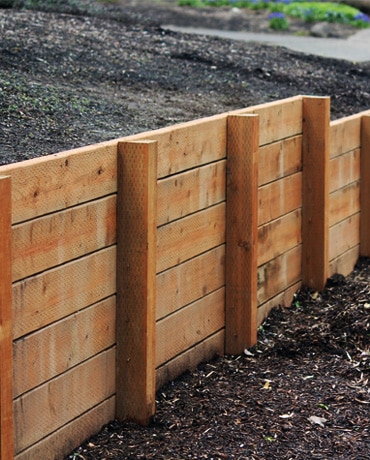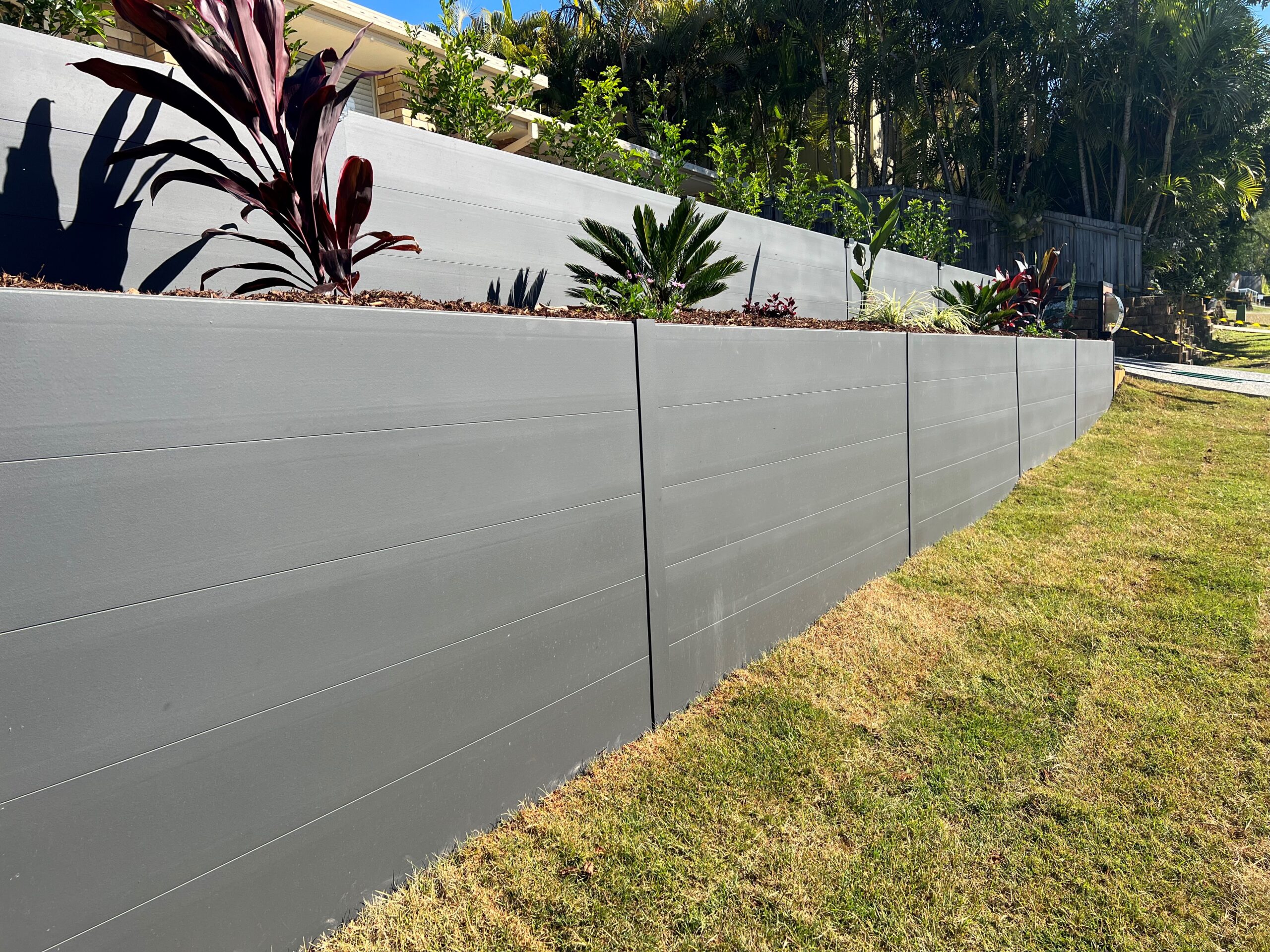Enhancing Residential Property Security: The Role of Retaining Walls in Soil Retention and Erosion Control
Preserving wall surfaces stand as silent guardians, playing an essential duty in dirt retention and erosion control. By checking out the subtleties of various types, design factors to consider, building and construction methods, and maintenance pointers linked with preserving walls, a deeper understanding of their essential function in enhancing building stability arises.
Relevance of Retaining Walls in Stability
Maintaining wall surfaces play an important function in holding back soil, protecting against disintegration, and developing level surfaces in sloped areas. By offering architectural support, maintaining wall surfaces assist to rearrange side stress triggered by dirt, preventing landslides and slippage.
Keeping wall surfaces are specifically important in hilly or irregular surfaces where dirt disintegration is a common occurrence. Without adequate assistance, soil disintegration can cause the destruction of landscapes, endangering the integrity of structures and positioning dangers to residents. Retaining walls work as obstacles, stabilizing the soil and stopping it from shifting downhill throughout heavy rains or other ecological stress factors.
Moreover, retaining walls offer lasting advantages by decreasing upkeep costs associated with soil disintegration and land instability. By buying well-designed maintaining wall surfaces, property owners can guarantee the long life and sustainability of their landscapes while promoting a visually attractive and risk-free atmosphere.

Sorts Of Retaining Walls for Disintegration Control
Gravity maintaining wall surfaces are sturdy structures that depend on their weight to stand up to the stress of the soil behind them. Cantilever maintaining wall surfaces, on the various other hand, are designed with a thicker base and use a bar arm to hold up against the soil pressure.
For taller walls or where area is a restraint, anchored preserving walls are frequently employed. These walls use cable televisions or strips that are secured right into the dirt or rock behind the wall to supply added assistance. An additional kind, the sheet heap retaining wall, is perfect for areas with soft dirt. Retaining Walls Sunshine Coast. These wall surfaces are composed of interlacing sheets that are driven right into the ground to produce a barrier against soil disintegration. When choosing the suitable sort of keeping wall for erosion control, aspects such as dirt composition, wall surface elevation, and website problems have to be carefully considered to guarantee long-lasting stability and efficiency.
Style Factors To Consider for Dirt Retention
When considering layout facets for effective soil retention solutions,Integrating the principles of structural engineering and environmental sustainability is important. When creating for soil retention, it is important to evaluate the certain requirements of the website, consisting of soil make-up, water drain patterns, and slope security. The elevation and location of the retaining wall surface are critical elements that affect the general layout. Engineers need to also think about the stress exerted by the retained dirt and prospective side tons to make sure the framework's security over time.
Furthermore, the product option for the maintaining wall surface is vital in boosting durability and capability. Concrete, wood, gabion baskets, and all-natural stone are usual materials made use of in keeping wall surface building, each with its special benefits and factors to consider. Correct drainage devices, such as weep holes and French drains pipes, ought to be incorporated into the style to stop water build-up behind the wall surface, which can result in structural failure and erosion.
Building And Construction Techniques for Retaining Wall Surfaces
When applying design considerations for efficient soil retention, the building methods for preserving wall surfaces play an important duty in making sure architectural honesty and lasting stability. The success of a keeping wall mainly relies on the construction approaches used. One common method is the gravity wall surface, which relies upon the weight and mass of the wall itself to withstand the pressure of the retained dirt. Gravity wall surfaces appropriate for low to tool heights and are fairly very easy to construct. Retaining Walls Sunshine Coast.
An additional extensively made use of building technique is the cantilevered wall, which utilizes a concrete piece structure that extends backwards right into the retained soil. This design offers added security and appropriates for tool to high keeping dig this walls. For taller frameworks, strengthened dirt strategies such as making use of geogrids or soil nails can be used to improve the wall's strength and security.

Upkeep Tips for Property Stability
To ensure long-term residential property stability, routine maintenance practices are vital for maintaining the stability of preserving walls and stopping disintegration issues. Examining keeping walls periodically is essential to recognize any type of indications of damages, such as splits, protruding, or leaning. Any issues ought to be dealt with immediately to stop further wear and tear. Cleansing the surface area of the preserving walls can also help maintain their structural integrity by eliminating dirt, particles, and vegetation that can deteriorate the wall over time (Retaining Walls Sunshine Coast).
In addition to visual evaluations and cleaning, it is essential to check the water drainage systems connected with the preserving wall surfaces. Ensuring that drains pipes are clear of blockages and functioning correctly can stop water accumulation behind the wall surfaces, which can result in stress and prospective failure. Appropriately functioning water drainage systems are vital for handling water circulation and minimizing the threat of disintegration.
Routinely monitoring and keeping maintaining walls according to these pointers can extend their lifespan and contribute to the total security of the residential property.
Final Thought
To conclude, keeping walls play an important role in enhancing home security by avoiding soil erosion and keeping dirt in place. By making use of different kinds of taking into consideration and retaining walls design and building strategies, home owners can effectively control erosion and preserve the stability of their land. Regular maintenance of retaining wall surfaces is important to ensure long-term stability and security versus disintegration. Appropriately constructed and kept preserving his response wall surfaces are essential elements in protecting property security.
For taller wall surfaces or where room is a restriction, secured retaining walls are often used. These walls make use of cable televisions or strips that are secured right into the soil or rock behind the wall surface to give extra assistance. When selecting the proper kind of maintaining wall for erosion control, aspects such as soil structure, wall elevation, and website problems have to be very carefully thought about to make sure resilient security and performance.
One usual method is the gravity wall surface, which depends on the weight and mass of the wall itself to withstand the stress of the retained dirt. Cleaning up the surface area of the preserving wall surfaces can additionally aid preserve their structural stability by eliminating dust, debris, and greenery that can deteriorate the wall over time.